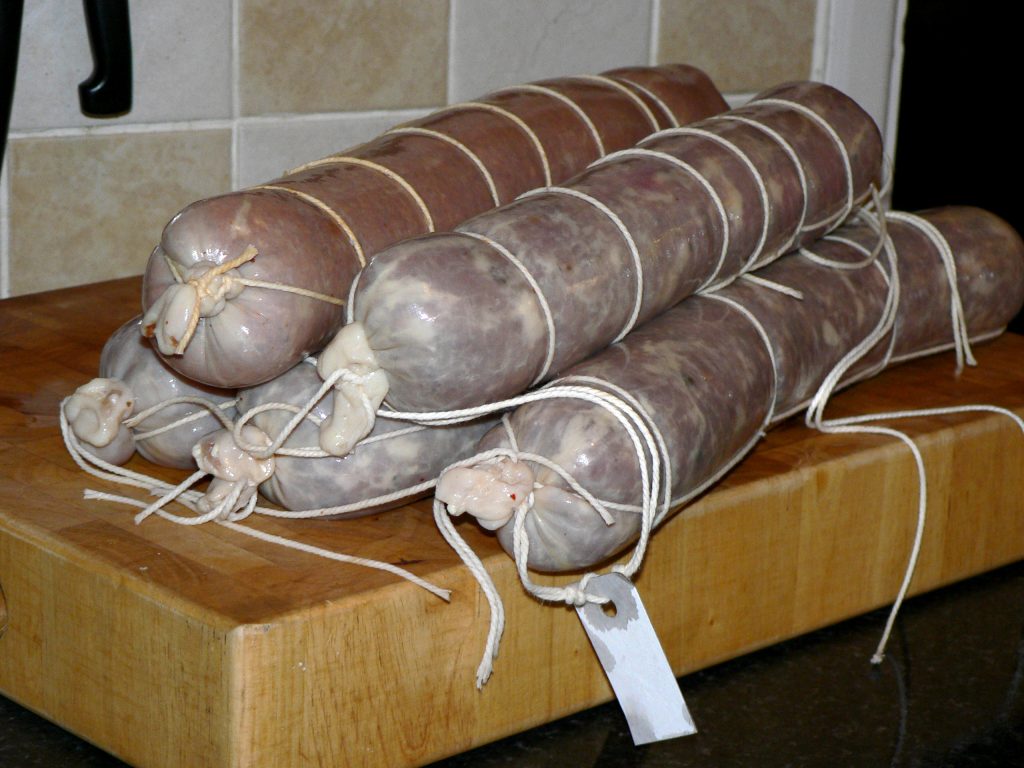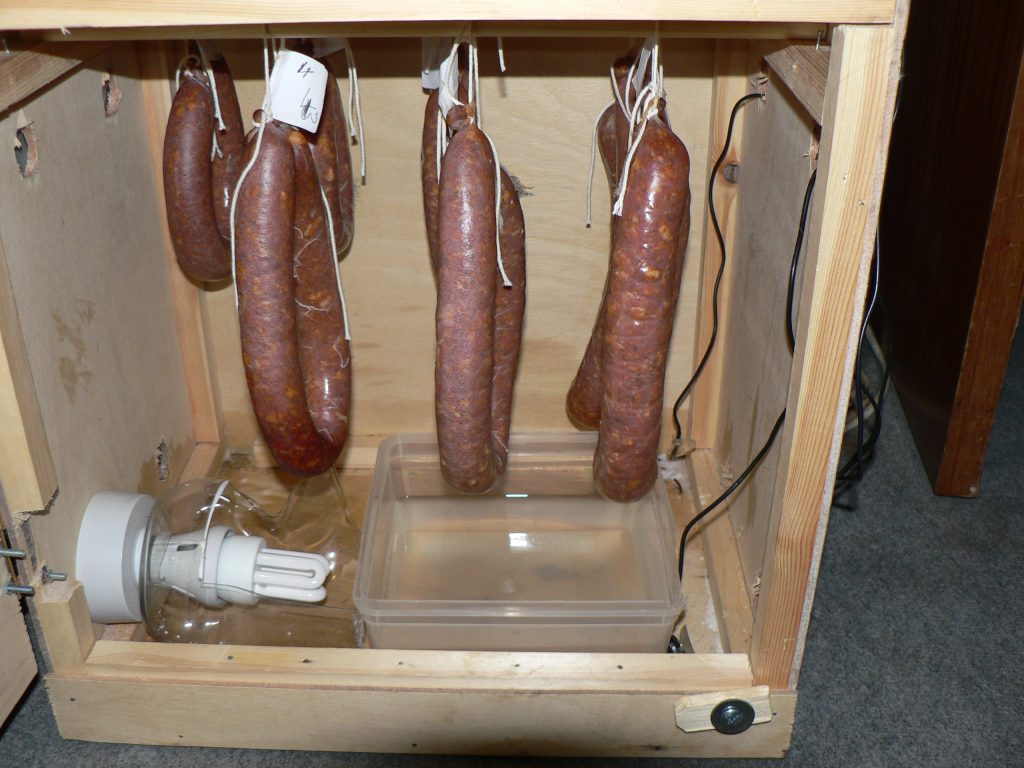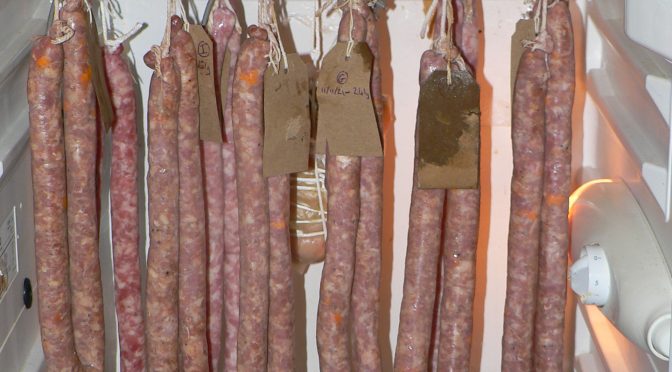An attempt to demystify the salami making process.
To overseas readers, I apologise that the links to suppliers are all UK based, however, the information is relevant regardless of that.

The basic process
- Making the sausagemeat
- Adding a salami culture
- Stuffing the sausagemeat into casings
- Fermenting them in a warm environment for a controlled time period
- Hanging them at a controlled temperature and relative humidity to dry
The rules
Many governments have rules about the production of commercial salami products even if it’s only the level of curing salts that are allowed in them. The USA and Canadian authorities also have rules governing the time drying and time allowed for fermentation – it’s to those rules I’ve looked for good practice in those areas. It makes sense for home producers to follow those rules or at least make informed decisions about choosing not to.
What makes uncooked ground pork put in a tube safe
The reason your salami will be safe to eat is a combination of things that stop undesirable bacteria from growing:
Keeping the meat at a safe temperature during processing. Store the meat below a maximum of 8°C and preferably below 5°.
Reduce the pH of the meat to increase its acidity to create an environment hostile to bacteria. We can test for this using a pH meter or pH test strips.
Reduce the moisture available in the meat for bacteria to feed on – reducing the water activity Aw. Meters to test this are very expensive so we’ll rely on weight loss to be an indicator of this happening.
Adding salt and curing salts to maximise safety.
Make the sausagemeat
Choice of meat
Given the investment of time and effort involved it makes sense to use the best meat you can. However, if standard commercial pork (commodity pork) is all that’s in your price range don’t be put off; you’ll still be able to make some good products. It goes without saying that it needs to be fresh.
Other Ingredients
The other common ingredients are:
Salt – Sea or rock salt without additives are good choices. In the US, kosher salt is the choice for most. The salt will help reduce the water activity.
Curing salts – Usually Cure #2 The cure will protect against botulism poisoning as well as contribute to the colour and flavour.
Spices – Sometimes whole spices but usually ground. Buying whole spices and grinding them is worth the effort. A coffee grinder is ideal for this.
Garlic – the subject of debate as fresh garlic can introduce unwanted bacteria. Many used powder or granules because of this. Others soak it in vinegar or wine or mash it with the salt to prevent this.
Sugar – added to feed the culture, often in the form of glucose/dextrose. Different cultures favour different forms of sugar with the amount available determining the final acidity.
Add a sausage culture
Adding a salami culture and fermenting the salami is what reduces the pH to help make the salami safe.
The cultures are available from ColdSmoking and also Weschenfelder’s. The most commonly used ones in the UK and the US are made by Hansen’s. They require storage in a freezer. The cultures contain lactic and other bacteria to make the salami safe. Different cultures are used for different types of salami – some ferment slowly, others are faster fermenting. However, there’s limited availability of most in the UK. Current options at sensible prices are:
T-SPX Bactoferm – for all fermented sausages where a slow, relatively mild acidification and flavour is desired. For fermentation temperatures not higher than 24º C (75º F). Additionally, the acidification profile must be rather flat not going below pH 4.8–5.0 at any time. This will ensure that the applied staphylococci maintain their activity over a longer period of time.
SafePro F-LC – for production of fermented sausages with either short or traditional production times. The mixture of bacteria ensures reliable acidification and strong flavour development with a good stable colour. Low fermentation temperature <25º C (<77º F) results in a traditional acidification profile whereas high fermentation temperature of 35-45º C (95-115º F) gives a fast fermented US style product.
LHP-DRY – for the production of traditional fermented, dry sausages with a distinctive sour flavour note. Extra fast culture targeted for fermentation temperatures 26–38°C (80–110°F).
Bessastart – a culture made by Moguntia, sold by Weschenfelders further details here (.pdf)
Stuffing into casings
Salami comes in all shapes and sizes as do the casings for them. The main choice is between natural and artificial. In order of size, natural casings are either sheep or pig (hog) for snack sticks and thin salami or beef (ox) for slicing salami. Artificial casings made from collagen are available in smaller sizes (edible). Larger sizes (inedible) are made from collagen or are fibrous. My choice is for sheep and pig casings for sizes up to about 42mm and fibrous ones for larger. Butchers Sundries have a good selection of artificial casings in quantities for home use.
Fermenting them in a warm environment

Once cased the salami needs fermenting to allow the culture to do its work. Some people will coat them with a mould culture at this time. In the UK this is only available in large quantities (approx. £50) so some people culture mould from a bought salami – mixing a piece of the skin with pure water and leaving it in a warm place. For those in the US the culture is available as Mold 600 from stores such as sausagemaker.com. When you case the salami it’s a good idea to keep the mix leftover in the stuffer to be able to ferment and test that rather than the cased salami. There are scant instructions on the culture packs as to how to conduct the fermentation process – time and temperatures but the Hansen’s catalogue gives some more information as should recipe instructions.
The fermentation will also need to be done in a high humidity environment – aim for 95% humidity. A sealed box in a warm location is often sufficient depending on the culture. Even better is a box with a controlled heat source such as a heat bulb or tubular heater.
The US and Canadian regulations limit the number of hours that a salami can be above 15.6°C – the temperature at which the production of the bacteria staph. aureus quickens. The target is to reach a pH of 5.3 within these limits.
Testing for pH can be done with test strips or a pH meter.
Details of the calculations along with a calculator are in my separate post about calculating fermentation times & temperatures.
Hanging them to dry
The salami is then hung to dry. You’ll need to keep them below 15.6°C (60°f) and keep the relative humidity around 75 – 80%. I find that 10 – 12 °C with an RH of 75% works well for me. Do not worry if the RH shoots up when you add new products – that’s normal. In an ideal world, we’d have the RH about 5% lower than the moisture in the salami but this is near impossible with a chamber of products made at various times. If you have a cellar or other area that’s naturally like this then that’s great. If the temperature’s good then humidity control is simple with a humidifier or dehumidifier. If not, a fridge can be converted at a reasonable cost.
Our aim is to dry them gradually until they are safe – about 35 – 40% weight loss. For peace of mind, a commercial producer told me recently that he’d never tested the water activity of salami and found it to be unsafe when it had lost over 35% of its weight. Obviously, our meat and conditions will differ from his, but it’s comforting to know this.

In your post you mentioned that you leave the salami to dry until its 35 – 40% reduced in weight. The next sentence you mention a commercial producer says anything over 35% is not safe. Not sure when it’s safe to eat.
Sorry Maureen, what he said was that he’d never seen one above 35% that wasn’t safe. I could have worded it better with hindsight.
Hi Phil
do you have any experience of using hog rings for tying off salami?
Secondly many thanks for all the tips and recipes you have published, I wouldn’t be selling charcuterie at farmers markets without your advice.
With respect to small producers and state regulation, is this something usually regulated via the ag department or health and safety? I can’t, for the life of me, find meat curing specific information for the state of Colorado (though, I’m just starting the search).
Hi David
I’m not really the best person to ask as I’m UK based. I know that there are USDA rules but not much more than that I’m afraid. A Facebook group like The Salt Cured Pig would be my ‘go-to’ place to ask. One of their moderators (Michele Tidd Pfannenstiel) is an expert in this field. I hope this helps.
Yeh David the USDA used to do alot more for canning and food presserving when every rural and many other households did it
so 50s and before but now they are more geared up to commercial production only and the info is just not all put online
maybe a direct request for the info is your best bet but no idea of the response time
can you FOIA it ? at least then you have a definite response time
well I now live in France and was always confused as to why the old houses had a row of small unglazed windows at the top
Inside the attic walls are about 2 ft high and the open windows are for ventilations to allow the drying
of hams sausages ect typically the pigs were killed ant of October onwards and the temp by then is mow enough to air dry the stuff safely
Saussison sec is normally a lot drier than salami and served with beer or appero’s as a nibble or just in the lunch box for a snack while at work